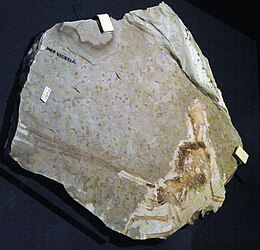| Scansoriopterygids Temporal range: Middle to Late Jurassic,
| |
|---|---|

| |
| Fossil specimen of Epidexipteryx hui | |
| Scientific classification | |
| Domain: | Eukaryota |
| Kingdom: | Animalia |
| Phylum: | Chordata |
| Clade: | Dinosauria |
| Clade: | Saurischia |
| Clade: | Theropoda |
| Clade: | Pennaraptora |
| Family: | †Scansoriopterygidae Czerkas & Yuan, 2002 |
| Type species | |
| †Scansoriopteryx heilmanni Czerkas & Yuan, 2002
| |
| Genera | |
Scansoriopterygidae (meaning "climbing wings") is an extinct family of climbing and gliding maniraptoran dinosaurs. Scansoriopterygids are known from five well-preserved fossils, representing four species, unearthed in the Tiaojishan Formation fossil beds (dating to the mid-late Jurassic Period) of Liaoning and Hebei, China.
Scansoriopteryx heilmanni (and its likely synonym Epidendrosaurus ninchengensis) was the first non-avian dinosaur found that had clear adaptations to an arboreal or semi-arboreal lifestyle–it is likely that they spent much of their time in trees. Both specimens showed features indicating they were juveniles, which made it difficult to determine their exact relationship to other non-avian dinosaurs and birds. It was not until the description of Epidexipteryx hui in 2008 that a subadult specimen was known. In 2015, the discovery of an adult specimen belonging to the species Yi qi showed that scansoriopterygids were not only climbers but also had adaptations that could have been used for gliding flight. The recently discovered (in 2019) Ambopteryx also supports this. The earlier described Pedopenna may also be a member of this clade.[1]